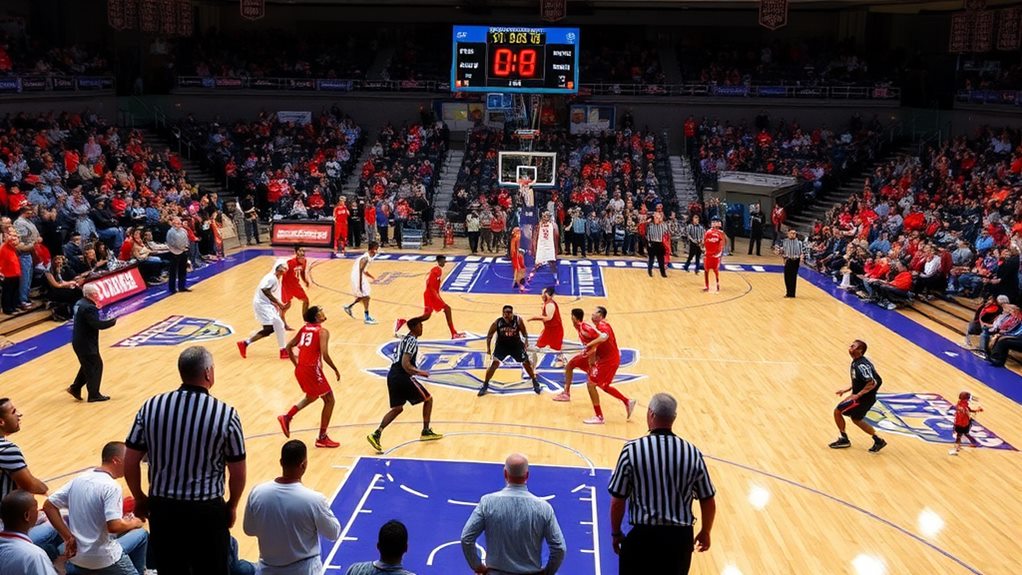
How Long Do College Basketball Games Last? Full Breakdown
November 30, 2024College basketball games usually last about 2 hours. Regulation play includes two 20-minute halves, adding up to 40 minutes. However, you can expect stoppages for fouls, timeouts, and out-of-bounds plays, which extend the game time. There's a 15-minute halftime break, plus potential overtime periods of 5 minutes if teams tie. With everything combined, it's common for games to stretch beyond 2.5 hours, especially with multiple overtimes. The structure of timeouts and television breaks can also influence the overall length. Stick around to uncover more details about the elements that shape your game experience.
Game Duration Overview
When you settle in to watch a college basketball game, you can expect it to last around 2 hours. The regulation time consists of 40 minutes, split into two 20-minute halves.
However, the actual duration of the game will usually exceed this due to various stoppages, much like how soccer matches account for stoppage time impacting their overall length. A typical halftime break lasts 15 minutes, giving teams a chance to regroup and fans a moment to enjoy some entertainment.
The average total duration of a college basketball game, including timeouts, fouls, and designated TV breaks, is approximately 2 hours. This means you should be prepared for the game to stretch a bit longer than the regulation time suggests.
If the teams are tied at the end of the second half, overtime periods come into play, each lasting 5 minutes. This can greatly extend the game duration, sometimes pushing it well beyond 2.5 hours.
Regulation Time Explained
In college basketball, regulation time consists of two 20-minute halves, but the actual game duration can stretch much longer.
With stoppages for fouls and timeouts, plus the potential for overtime if the score is tied, you might find that a game lasts around 2 hours.
The impact of data-driven strategies can also be seen in how teams manage their timeouts and substitutions, further influencing the game's flow.
Understanding these elements helps you appreciate how the clock impacts the flow of play.
Halves Duration Explained
College basketball games are structured into two halves, each lasting 20 minutes for a total of 40 minutes of regulation play. However, the actual game time often extends beyond this due to various interruptions. The clock stops for fouls, timeouts, and when the ball goes out of bounds, which means the overall duration can stretch considerably.
Between the two halves, there's a halftime break that typically lasts 15 minutes, giving players a chance to regroup and fans a moment to enjoy some entertainment. This break is essential for teams to adjust their strategies and rest before the second half begins.
If the score is tied at the end of regulation, the game doesn't just end there; overtime periods of 5 minutes are played until a winner is determined.
It's crucial to recognize that while the regulation consists of 40 minutes, the average total duration of a college basketball game, including all stoppages and timeouts, is about 2 hours.
Overtime Impact on Duration
Overtime can greatly extend the duration of college basketball games, especially when teams are evenly matched. A standard college basketball game lasts 40 minutes of regulation time, split into two 20-minute halves. However, if the score is tied at the end of regulation, overtime periods work to determine a winner, each lasting 5 minutes. This can greatly increase the actual game length, especially with additional overtime periods.
While the average duration of a college basketball game hovers around 2 hours, this figure can rise dramatically if multiple overtimes are played, potentially stretching the total game length to 2.5 to 3 hours or more. Each overtime period grants teams an extra 30-second timeout, allowing for strategic pauses that can also extend the game.
The longest recorded college basketball game lasted an astonishing 3 hours and 53 minutes, featuring seven overtime periods. Such extreme cases highlight how various factors can influence the total duration of a college basketball game.
Stoppages and Game Clock
Basketball games are dynamic events where the game clock frequently stops for various reasons, impacting the flow and duration of the match. In college basketball games, regulation time consists of 40 minutes divided into two 20-minute halves.
However, the actual time you spend watching the game is often much longer due to numerous stoppages. The game clock halts for fouls, timeouts, and out-of-bounds plays, which can greatly extend the match's overall duration. Each team has four timeouts during regulation, adding to these stoppages.
Additionally, scheduled TV timeouts occur at specific intervals—after the first dead ball at the 16, 12, 8, and 4-minute marks of each half—further increasing the time you'll spend watching.
When you add up all these factors, the average total game time, including all stoppages and interruptions, is approximately 2 hours. This duration can easily exceed that if there's overtime or extended timeouts.
Overtime Rules and Implications
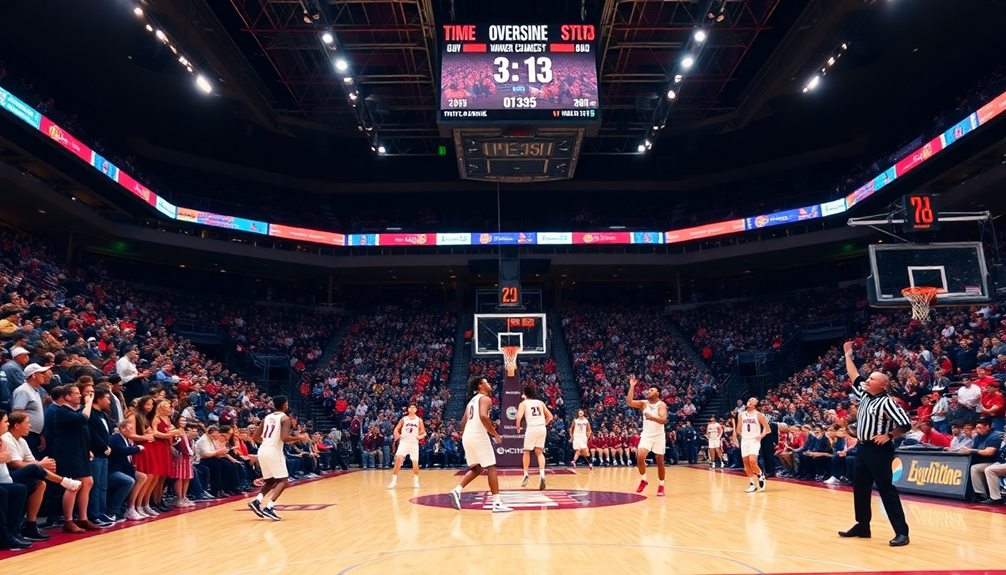
When a game ends in a tie, the excitement ramps up as teams head into overtime. Each overtime period lasts 5 minutes, providing a thrilling extension of the game beyond the standard 40 minutes of regulation time. This strategic element can lead to teams employing smart defensive tactics to counteract fatigue and maintain their edge.
If the score remains tied after the first overtime, multiple overtime periods can occur, greatly extending the game's duration and heightening the unpredictability of the outcome.
Teams get one additional timeout for each overtime period, plus any unused timeouts from regulation. This strategic element can influence the flow of the game, as coaches have more opportunities to make critical adjustments.
The clock also resets for team fouls at the beginning of each overtime, allowing players to commit fouls without the immediate worry of disqualification, which can change the dynamics on the court.
Impact of Timeouts
As the intensity of the game heightens, the impact of timeouts becomes more pronounced. Each college basketball team gets a total of four timeouts during regulation play, including one 60-second and three 30-second timeouts. This strategic use of timeouts allows coaches to regroup, adjust tactics, and potentially shift the game's momentum, which is particularly important when facing diverse playing styles from international opponents analyzing international opponents' playing styles.
If a team hasn't used its 60-second timeout in the first half, it carries over into the second half, offering further flexibility.
In addition to team timeouts, scheduled TV timeouts occur at significant moments—specifically after the first dead ball at the 16, 12, 8, and 4-minute marks in each half. These TV timeouts contribute to the overall game length, adding to the overall game duration while interrupting the flow of the game.
Although these breaks can disrupt momentum, they also provide teams with essential moments to strategize and recover.
During overtime, each team receives an additional 30-second timeout, and any unused timeouts from regulation can still be leveraged. Consequently, the impact of timeouts is multifaceted, influencing both the tactical approach and the pacing of college basketball games.
Television Timeout Details
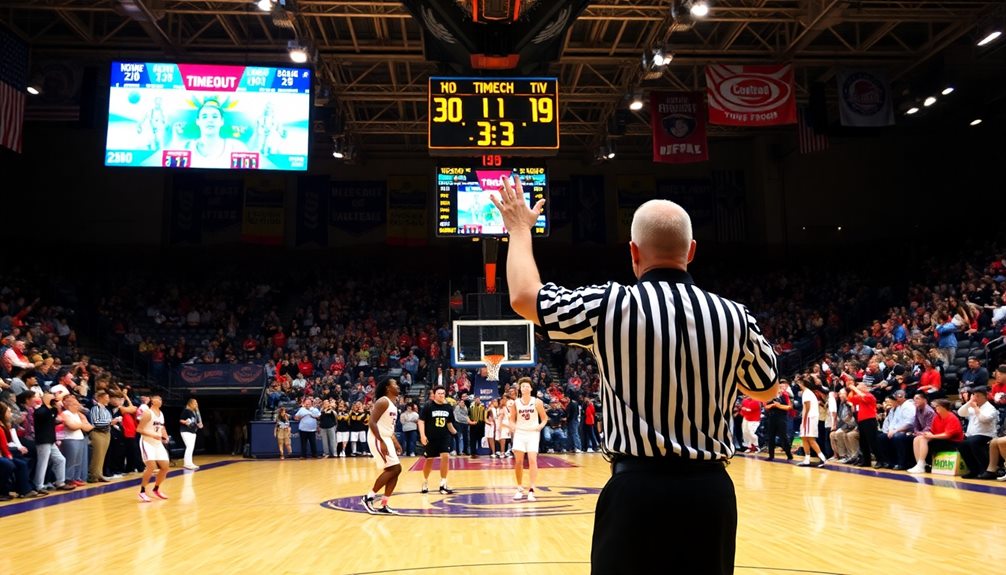
When you watch a college basketball game, you'll notice scheduled TV timeouts happening at specific points in each half. These timeouts not only create breaks for advertising but also add about 15-20 minutes to the game's total duration.
Understanding how these timeouts fit into the game can give you a clearer picture of what to expect when tuning in.
Additionally, just like in soccer where player conduct and teamwork are essential, effective communication during timeouts can greatly impact a team's performance and strategy in basketball.
Learn more about player conduct and team dynamics to appreciate the game's intricacies even further.
Scheduled TV Timeout Timing
Scheduled TV timeouts play an essential role in the flow of college basketball games, occurring at the first dead ball after the 16, 12, 8, and 4-minute marks of each half.
These breaks guarantee that when the game is televised, there's ample opportunity for commercial breaks, benefiting both broadcasters and advertisers. In total, you can expect eight scheduled TV timeouts during a game, four in each half.
If a team calls a timeout within 30 seconds of a scheduled TV timeout, that timeout will count as the TV timeout. Similarly, if a video review occurs within that same 30-second window, it will trigger a TV timeout as well.
This consistent timing helps maintain a rhythm in the game while allowing for necessary television coverage.
The scheduled TV timeouts not only provide vital advertising space but also allow fans a chance to catch their breath and discuss the action.
Understanding these timeouts enhances your viewing experience, as you'll know when to expect pauses in the game.
Impact on Game Duration
The presence of scheduled TV timeouts can greatly affect the overall duration of college basketball games. These timeouts occur at the first dead ball after the 16, 12, 8, and 4-minute marks of each half, totaling eight for a televised game. Each TV timeout lasts longer than regular team timeouts, stretching game duration considerably.
When teams call timeouts within 30 seconds of a scheduled TV timeout, those automatically count as the TV timeout, avoiding extra stoppage time. However, if a video review happens in that window, it'll trigger another TV timeout, further extending the game.
The impact of these TV timeouts can add approximately 10 to 15 extra minutes to the overall game duration. This means that while regulation time consists of only 40 minutes, fans should expect to spend much longer in the arena or glued to their screens.
Factors Affecting Game Length
Several factors influence the length of college basketball games, often pushing them beyond the 40 minutes of regulation play. While the game consists of two 20-minute halves, actual game time can stretch markedly due to stoppages.
One of the key factors affecting the length is the timeouts in college basketball; each team gets four timeouts during regulation—one lasting 60 seconds and three lasting 30 seconds. Additionally, scheduled TV timeouts occur at the 16, 12, 8, and 4-minute marks, which can further extend the game, especially if teams use their timeouts at the same time.
Understanding rules and regulations is vital for fans as it enhances the overall enjoyment of the game. Frequent fouls also play a role, leading to free throws that slow the game down, contributing to longer overall durations.
Injuries can cause delays as well, whether it's for player treatment or substitutions. All these elements combine to create the average college basketball game lasting around 2 hours, factoring in all the stoppages.
Comparing Other Basketball Formats
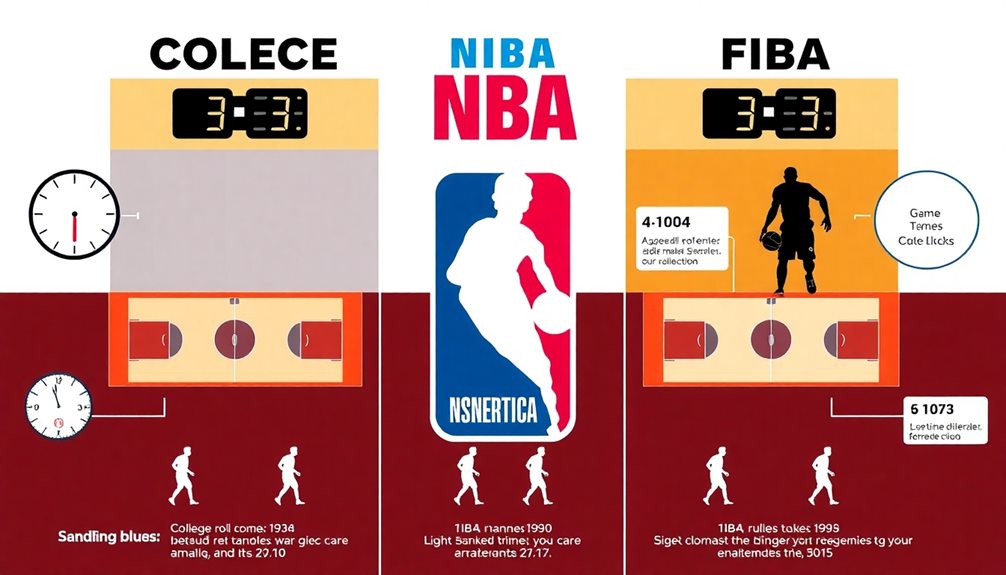
When you compare various basketball formats, you'll notice distinct differences in game structure and timing. Each level has its unique rules, affecting overall game duration. The evolution of defensive strategies, such as the shift from man-to-man to zone defense, has also influenced how teams manage their timeouts and play styles during these games.
Here's a quick breakdown:
- College Basketball Games: These consist of two 20-minute halves, totaling 40 minutes of play. With timeouts and halftime breaks, the overall duration can stretch considerably.
- High School Basketball: Typically played in four 8-minute quarters, high school games last 32 minutes of play. However, due to stoppages, these games can also last between 1.5 to 2 hours.
- NBA Games and FIBA Games: NBA games feature four 12-minute quarters, totaling 48 minutes. FIBA games, on the other hand, have four 10-minute quarters, also equating to 40 minutes of play. Both formats include timeouts and can extend with overtime periods of up to 5 minutes.
In comparing these formats, college basketball games usually have a longer overall duration due to the number of stoppages and the structure of the game, making them unique in the basketball landscape.
Fan Engagement and Experience
College basketball games offer more than just a set duration of play; they create an immersive experience that captivates fans from start to finish. The vibrant atmosphere in the arena, fueled by passionate supporters, transforms each game into a thrilling event.
You'll find yourself swept up in the excitement as you cheer alongside fellow fans, creating a strong sense of community. This sense of belonging can be enhanced by understanding the team's culture and traditions, which deepens your emotional investment in the game and its players the importance of fan engagement.
As the game unfolds, every heart-stopping play and thrilling finish draws you deeper into the action, enhancing your emotional connection to the team. The experience doesn't stop at the final whistle; halftime performances and interactive contests keep you engaged and entertained.
Whether it's a dance-off or a chance to win prizes, these activities add layers to your enjoyment. Victory celebrations are particularly euphoric, as they bring fans together in shared joy, making the atmosphere even more electric.
This combination of exciting moments, fan engagement, and the overall experience is what sets college basketball apart. You're not just watching a game; you're part of something bigger, creating memories that last well beyond the final buzzer.
Importance of Game Duration
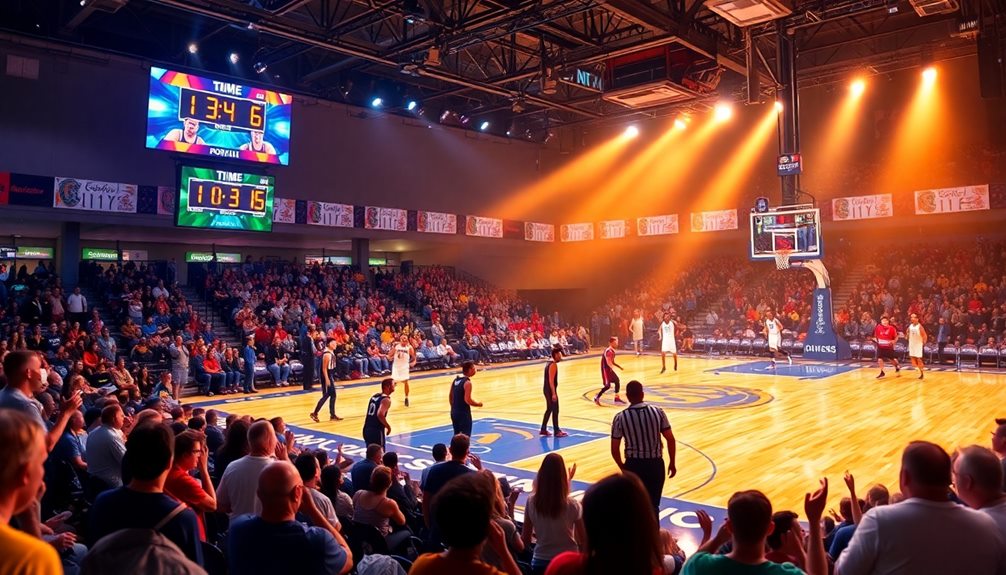
Understanding the importance of game duration enhances your overall experience as a fan. In college basketball games, the regulation time is 40 minutes, split into two 20-minute halves. However, the actual game duration often stretches to about 2 hours due to various factors, such as halftime duration variations that allow players to recover and strategize.
Here are three key reasons why understanding game duration matters:
- Game Flow: Recognizing that game duration includes TV timeouts, halftime breaks, and stoppages allows you to anticipate the rhythm of the game. This helps you stay engaged and enjoy the excitement without feeling rushed.
- Strategic Insights: Knowing how overtime periods can extend the game length enables you to appreciate the strategies employed by teams, especially when matches are closely contested. Each overtime adds 5 minutes to the clock, potentially leading to thrilling finishes.
- Time Management: Being aware that the average game time can exceed 2.5 hours, especially in cases of multiple overtimes, helps you plan your day better. You won't find yourself caught off guard, missing out on key moments.
Conclusion
So, the next time you settle in to watch a college basketball game, remember it's more than just the clock ticking down. With regulation time, potential overtime, and those vital timeouts, each game can turn into a thrilling experience that keeps you on the edge of your seat. You might just find yourself cheering for a buzzer-beater or groaning over a missed shot, all while realizing that every second counts in this electrifying sport.


